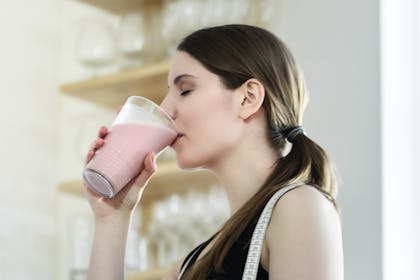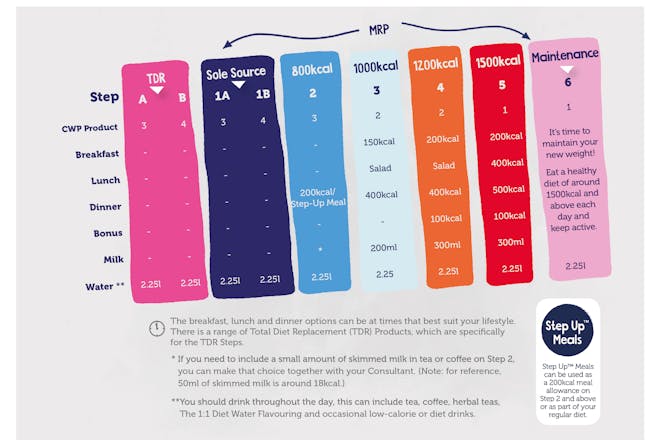How does the Cambridge Diet work and what are the Steps?

The Cambridge Diet – officially called The 1:1 Diet by Cambridge Weight Plan – is popular with people looking to lose a lot of weight quickly. Find how it works, what the different Steps are all about – and whether it's safe to do when you’re trying to conceive (TTC), pregnant or breastfeeding.
This page contains affiliate links, which means we may earn a small amount of money if a reader clicks through and makes a purchase. All our articles and reviews are written independently by the Netmums editorial team.
What is The Cambridge Diet?
The Cambridge Diet is a rapid weight loss programme developed in the '60s by Dr Alan Howard at Cambridge University (hence the name). These days, it's officially called The 1:1 Diet by Cambridge Weight Plan.
The main idea of the diet is to replace much (or even all) of your normal food with meal-replacement products such as soups, shakes and bars, which you have to buy.
Depending on how much weight you want to lose, there’s a choice of six diet plans known as 'Steps'.
These range from a very low calorie plan (sometimes known as the ‘Sole Source’ plan, where you only eat official 1:1 products) through to 1,500 calories (the ‘Maintenance’ plan where you eat low calorie meals alongside the products.)
How does The Cambridge Diet work?
The Cambridge Diet (or 1:1 diet) works in part by forcing your body into a state of ‘ketosis’. This is basically where your body isn’t getting enough calories from carbohydrates so it resorts to burning your own fat stores instead.
This is similar to the Keto diet.
The plan is quite extreme and you can’t follow it on your own.
Instead you need to sign up with a 1:1 Cambridge Weight Plan consultant who will give you one-to-one advice and support on what to eat.
You're also advised to check with your doctor before starting the diet plan.
The 1:1 consultant will weigh and measure you to decide which programme is best for you and help you achieve your weight loss goals.
The Cambridge Diet: what are the different Steps?
There are six different diet stages, each known as Steps, that tell you how many calories and what you can eat each day.
Your 1:1 consultant will help advise you which Step to start on – for example, you can start from Step 3 if you don't want the really low calorie intake in Steps 1 and 2. You can also move from Step to Step whenever you like.
Here's what each Step involves:
Cambridge Diet Step 1
Eat three or four 1:1 diet products and drink 2.25 litres of water a day.
On Step 1, you'll only be getting between 415 and 554 calories a day in total.
You can only do Step 1 for a maximum of 12 weeks. This step is designed to kick-start your weight loss, and is also great if you just want to lose a few pounds for a one-off special event. But it's not a good long-term option, as you won't be getting all the calories and nutrients you need.
Cambridge Diet Step 2
Eat three 1:1 diet products and one healthy meal of your choice – Cambridge Weight Plan also offer low-cal 'Step Up Meals', or you can make your own. You should continue drinking the same amount of water and you can also have tea and coffee.
On Step 2, you'll be getting roughly 800 calories a day in total.
This step aims to ease you back in to eating regular foods, though it's still a very low-calorie option.
Cambridge Diet Step 3
Eat two 1:1 diet products, one healthy breakfast, light lunch, and a low-calorie dinner. As before, you need to drink a minimum of 2.25 litres of water.
On Step 3, you'll be getting roughly 1,000 calories a day in total.
The 1:1 diet products can include their healthy meals (such as beef casserole and vegetable soup), or their tasty snacks (such as cherry bakewell flavour bar).
Cambridge Diet Step 4
Eat two 1:1 diet products, one healthy breakfast, light lunch, and low-calorie dinner, plus a couple of healthy snacks. Keep it up with the 2.25 litres of water, too.
On Step 4, you'll be getting roughly 1,200 calories a day in total.
Step 4 of the plan is ideal for people with more active lives, who may need a few more calories to help them get through the day. The extra healthy snacks will give you the boost you need, plus a chance to get a wider variety of nutrients in your diet.
Cambridge Diet Step 5
Eat one 1:1 diet product, one healthy breakfast, one light lunch and one low-calorie dinner. Continue to drink at least 2.25 litres of water.
On Step 5, you'll be getting roughly 1,500 calories a day in total.
This is still a low calorie diet, but you're much closer to eating normal food now. This step helps you get used to healthy eating without relying so much on the 1:1 diet products.
Cambridge Diet Step 6
This is the maintenance stage, where you are now eating to maintain your weight loss and make sure you don't put the weight back on again.
After each stage, your 1:1 diet consultant will advise you on how to start slowly introducing regular foods again. They'll help you work out the best step for you, and give you plenty of motivation to stay on track.

Is The Cambridge Diet right for me?
The first thing you should do is work out your BMI to see if you need to lose weight.
The 1:1 diet website has a BMI calculator you can use.
If your BMI is over 25, you are classed as overweight and can do The 1:1 diet. However, you are advised to talk to your GP before starting any weight loss programme. People who are underweight shouldn't do the Cambridge Diet.
Cambridge Diet Plan states that it's not suitable for you if:
- Your BMI is below 20
- You have an eating disorder
- You are under 14 years of age
- You have had a heart attack or stroke in the past three months
- You are taking prescribed monoamine oxidase inhibitor medication
- You are taking anti-obesity medication
- You are a substance misuser or dependent on alcohol
- You are pregnant or breastfeeding, or have given birth in the past 3 months
Linia Patel, a dietitian and British Dietetic Association spokeswoman says:
'There are a few different plans within The 1:1 diet. However, overall The 1-1 diet isn’t sustainable. If you follow the very low calorie diet (500 calories per day for example) you risk losing precious muscle mass.'
How much weight will I lose on The Cambridge Diet?
Your weight loss is likely to be quite quick as the number of calories you are eating as so restricted.
This is especially true in Step 1 when you're having as little as around a quarter of the recommended daily calorie intake for women.
The 1:1 diet 'Woman of the Year' for 2021 was Rachael Walkingshaw-McGuinness who lost 9st 1.5lb on the plan, while another dieter lost over 12 stone.
It's worth noting that the NHS recommends slower weight loss saying you should:
'Aim to lose weight at around 0.5kg to 1kg a week (1lb to 2lb)'
Will The Cambridge Diet affect my fertility?
Following a healthy, balanced diet is recommended if you’re trying to get pregnant.
As such, The Cambridge Diet might not be right for you – especially if you’re on the very low-calorie plan as you may not be getting enough calorie and nutrients your body needs.
Dietician Linia says:
‘The 1,500 kcal per day plan may be a way to kick start weight loss before you conceive. However, I would recommend that you work with a dietitian or registered nutritionist to ensure effective weight loss and sustainability in the long term.
‘Using it as a starting point, you can then work with a dietitian to start incorporating more solid food.’
According to Cambridge Weight Plan, losing weight quickly can affect your periods, too. On its website it explains:
‘In most cases the menstrual cycle remains unchanged but for some women breakthrough bleeding or heavier periods may occur. Others may find that their periods stop for a while.
‘Fertility may also be affected and unexpected pregnancies have been known to occur, therefore if you have been trying unsuccessfully to become pregnant, you need to be aware that during and after weight loss, fertility may increase.’
Can I do The Cambridge Diet if I’m pregnant?
No, you won’t be allowed to sign up for The 1:1 diet if you’re:
- pregnant
- breastfeeding
- have given birth in the last three months
During these times, your body needs more calories than the 1:1 diet can provide.
Can I do The Cambridge Diet if I’m breastfeeding?
No, as above, the diet is not suitable for breastfeeding women.
Christine says:
‘Pregnant and lactating women require increased levels of protein and energy, and are advised to follow a diet rich in lean protein, whole grains, fresh fruit and vegetables.’
What are the side-effects of The Cambridge Diet?
Eating so few calories can have a number of physical side effects. These can include:
- bad breath
- feeling cold, especially your hands and feet
- headaches
- a dry mouth
- tiredness and/or insomnia
- dizziness
- changes to your periods (heavier, spotting or stopping altogether)
- constipation (from cutting down your fibre)
- diarrhoea (from increased mineral consumption)
- hair loss
These side-effects can happen with any very low calorie diet. If you're experiencing side-effects of weight loss, chat to your GP. You should also always check with your GP before starting a strict diet if you have any kind of health condition.
What are The Cambridge Diet products?
If you follow the diet plan, a lot (or all) of what you eat will be 1:1 diet products.
These meal replacements are full of the vitamins and minerals you need to stay healthy and include:
- low-calorie shakes
- soups
- smoothies
- porridge
- snack bites
- meal replacement bars
- meal replacements, such as spaghetti bolognese flavour pasta or chicken tikka style curry
- Step Up meals, such as chicken tagine with chickpeas or smoky three bean and lentil casserole
Keeping a food diary or using a diet planner can help keep you focussed. We like this planner that comes with a calorie counter, mood tracker, plus stickers to help you track your progress. See more details here at Amazon.
Using a plate with portion sizes can help you eat more balanced meals – we like this attractive ceramic one that also comes with lots of healthy eating advice. See more details here at Etsy.
How much does The 1:1 diet cost?
It costs around £55.02 a week, which is based on three products a day and a weekly one-to-one session with your 1:1 diet consultant.
Cambridge Diet reviews
Here's what Netmums' forum has to say about the Cambridge Diet:
'I'm on week 13 now, started on ss [Sole Source] now on step 2 weight loss to date 3st 10lbs.....1st 13lbs to go' - Kelly C
'It took me 12 weeks to lose 3 stone. The first 28lb were lost by week 3. It is an amazing diet for weight loss if you stick to it 100%. But not the best diet health wise. My periods virtually stopped, nails went thin brittle, hair began to thin rapidly, so by week 13 I stopped.' – Emma
'I was on it last May for a bit, trying to lose some weight before my wedding, found it fairly easy to stick to it, until I had 1 night off for a friends bbq, then I found it so hard to get back on it and stick to it 100% so ended up giving up as was just wasting money.' – Stacey C
Have you tried The Cambridge Diet? Chat about it in our forum below, or check out our articles for more slimming tips:
Related stories
Everything you need to know about Slimming World



